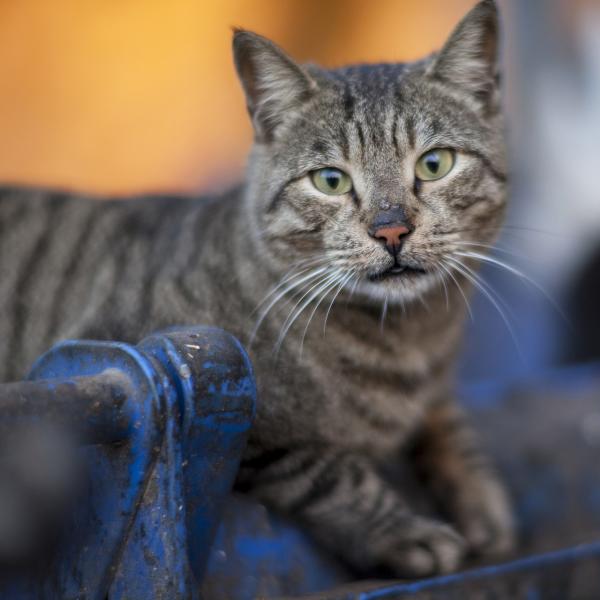Diseases that a stray cat can transmit

Statistics say that cats that live indoors live, at least, twice as long as cats that stay outdoors. This is mainly due to the fact that they have a lower risk of suffering diseases and pathologies, infections that risk their lives. However, what happens when the desire is to adopt a cat that has lived on the street? In this case, many doubts arise, especially in regard to the diseases that a stray cat can bring, which can cause concern.
Do not let this uncertain stop you to help a street who needs it. Before making the right decision, in, we invite you to inform yourself with this article about the diseases that a stray cat can transmit.
Toxoplaxmosis
Toxoplasmosis is one of the contagious diseases that street cats can transmit and that they worry more to the human beings, especially to the pregnant women, who, besides those people with a compromised immune system, turn out to be the most prone. It is transmitted by a parasite called toxoplasma gondii that is in the feces of the felines. It is one of the most common parasitic pathologies and affects both cats and humans, with cats being the main guest.
Toxoplasmosis is an exaggerated disease with a lot of misinformation. In fact, it is considered that a good part of the companions of cats have contracted the disease without knowing it, since many of them do not show symptoms. The only real way to get infected with this disease is ingesting infected cat feces, even a small amount. However, you might think that nobody does that on purpose, however, when the sandboxes are cleaned, sometimes, it ends up with some fecal matter on the hands, which is then unconsciously brought to the mouth by the fingers or eating food with their hands, without previously washing them.
The way to avoid toxoplasmosis is to wash your hands right after picking up the litter box and make it a habit. In many cases until the treatment is not usually necessary, but when it is recommended it consists of the ingestion of antibiotics and antimalarial drugs.

The rage is a viral infection of the central nervous system which can be transmitted by animals such as dogs and cats. To contract it, the saliva of the infected animal must enter the body of the person. The rage is not contagious to touch a rabid cat, this can happen by a bite or if the animal licks a wound that is open. It is one of the diseases that can be transmitted by street cats and that most concern because it could be fatal. However, this happens only in extreme cases, usually rabies is treatable if medical attention is received promptly.
If a person is bitten by a cat with this condition, it will not always contract the pathology. And if the wound is washed with care and immediately with soap and water for several minutes, the chances of getting a contagion are still reduced. In fact, the chances of getting this disease from a stray cat is very low.
To avoid any risk of biting, do not try to pet or pick up a stray cat without first giving him all the signs that he accepts your approach. A feline open to human contact will be happy and healthy, will purr and seek to rub against your legs in a friendly way.

Cat-scratch disease
This is a very rare disease but. fortunately, benign and of spontaneous healing, that is to say, that does not require treatment. Cat scratch disease is a infectious pathology produced by a bacterium of the genus Bartonella. This bacterium is present in the blood of the cat, but not in all. In general, felines are infected by fleas and ticks that carry the bacteria. This “fever”, as some call the pathology, is not a cause for concern, unless you are a person with compromised immune systems.
Do not reject cats because of this. Cat scratch disease is not an exclusive pathology of these animals. A person could also get infected by scratches from dogs, squirrels, a scratch with barbed wire and even thorny plants.
As with rabies, to avoid any chance of being infected, just touch the stray cat after it has given clear signs of acceptance. If you get to pick him up and he bites or scratches you, quickly washes the wound thoroughly to avoid any infection.

Ringworm is part of the diseases that street cats can transmit and it is a very common and contagious, but not serious, body infection, caused by a fungus that looks like a red circular patch. Animals like cats can be affected by ringworm and can infect humans. However, this is not a strong reason not to adopt a stray cat.
While a person can get the ringworm of a feline, it is more likely that he will contract it from another person in places like changing rooms, swimming pools or wet spaces. The application of topical fungicidal medications are usually sufficient as a treatment.

Feline immunodeficiency virus and feline leukemia
FIV (the equivalent of HIV in cats) and feline leukemia (retrovirus) are both immunodeficiency diseases that damage the cat’s immune system, which makes it difficult to fight other diseases. Even though humans do not contract these diseases, it is important to mention that if you have other cats at home, they will be exposed and at risk of becoming infected if you bring a street cat home. Before taking the step, we recommend that you take it to your trusted veterinarian to rule out any type of contagious infection, especially the feline immunodeficiency virus and feline leukemia. And in case of being infected, we advise you to go ahead with your decision to adopt it but taking the appropriate preventive measures to prevent it from spreading to other cats, as well as offering the appropriate treatment.

This article is merely informative, in .com we do not have the faculty to prescribe veterinary treatments or make any kind of diagnosis. We invite you to take your pet to the veterinarian in case of any type of condition or discomfort.
If you want to read more articles similar to Diseases that a stray cat can transmit, we recommend that you enter in our Prevention section.


